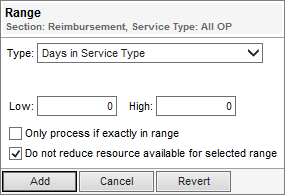The Range tool calculates reimbursement based on a range of values for a specified operand.

Note: You must use the Range tool in conjunction with at least one other term.
For most operands selected in the Range tool, the range limits must be defined using the Low and High boxes.
- The Low and High values must be a whole number greater than or equal to one.
- For ICD-10 codes, the Low and High values must be the same and you must select Only process if exactly in range.
Note: You can enter alphanumeric characters in the Low and High boxes for the Days Prior to Procedure operand to accommodate ICD-10 codes.
The following operands the Range tool provide options to define the Low and High values in the range, or to select a lookup table to define the range.
- Days Prior to Procedure
- ICD (Any) Code
- ICD Primary Code
Note: When an existing ICD-9 contract using the Range tool with these operands is converted to ICD-10, the Range tool will be updated with the Table option and the auto-generated lookup table is selected. The auto-generated lookup table will contain ICD-9 and ICD-10 (unclustered) codes.
If you select the Range option, claims are priced using the range of codes defined in the Low and High boxes.
- The Low and High values must be a whole number greater than or equal to one.
- The codes entered in the Low and High boxes must be either ICD-9 or ICD-10. They cannot be mixed.
- For ICD-10 codes, the Low and High values must be the same and you must select Only process if exactly in range.
If you select the Table option, claims are priced using codes defined in the selected lookup table.
- Mixed (ICD9 & ICD10) lookup tables contain both ICD9 and ICD10 codes, and they can be used to reprice claims containing either ICD-9 or ICD-10 codes.These tables can be created manually, or they can be auto-generated when a Service Type Definition table is converted to ICD-10.
- For the Days Prior to Procedure operand, if an ICD-10 claim matches on multiple codes contained in the new lookup table, it will reprice using the code on the claim with the earliest date.
The following table describes the fields on the Range tool.
Field | Description |
Type | Operand to which the range is applied |
High | Highest value in the range |
Low | Lowest value in the range. Must be a whole number greater than or equal to one |
Table | The lookup table containing the range of codes. This field is only available for the following operand types when the table option is selected:
Note: When an existing ICD-9 contract with these operands is converted to ICD-10, the Range tool will be updated with the Table option and the auto-generated lookup table is selected. The auto-generated lookup table will contain ICD-9 and ICD-10 (unclustered) codes. |
Do not reduce resource availability for selected range | Only applies when the Type is Days in Service Type |
Only process if exactly in range | When selected, restricts processing to the exact range you entered |
